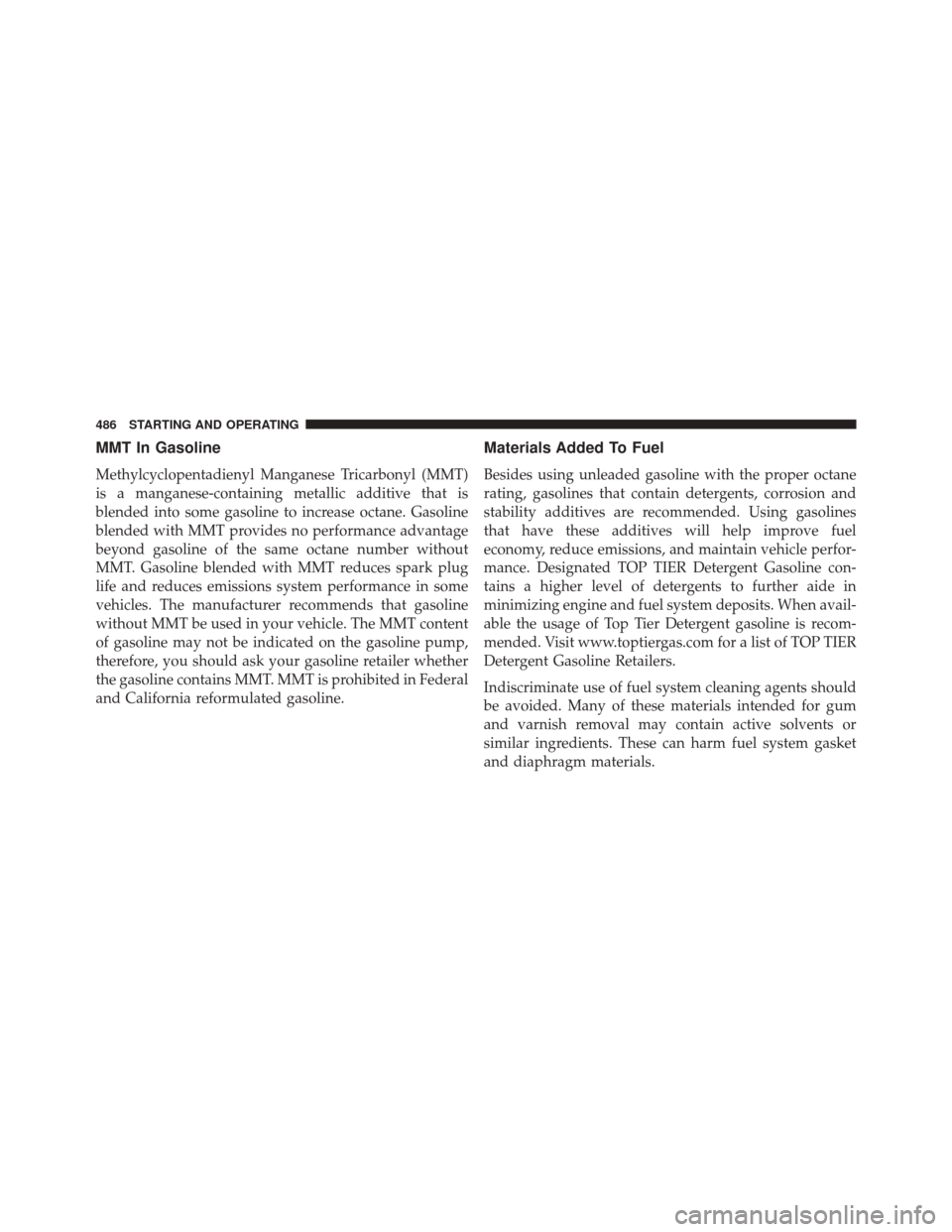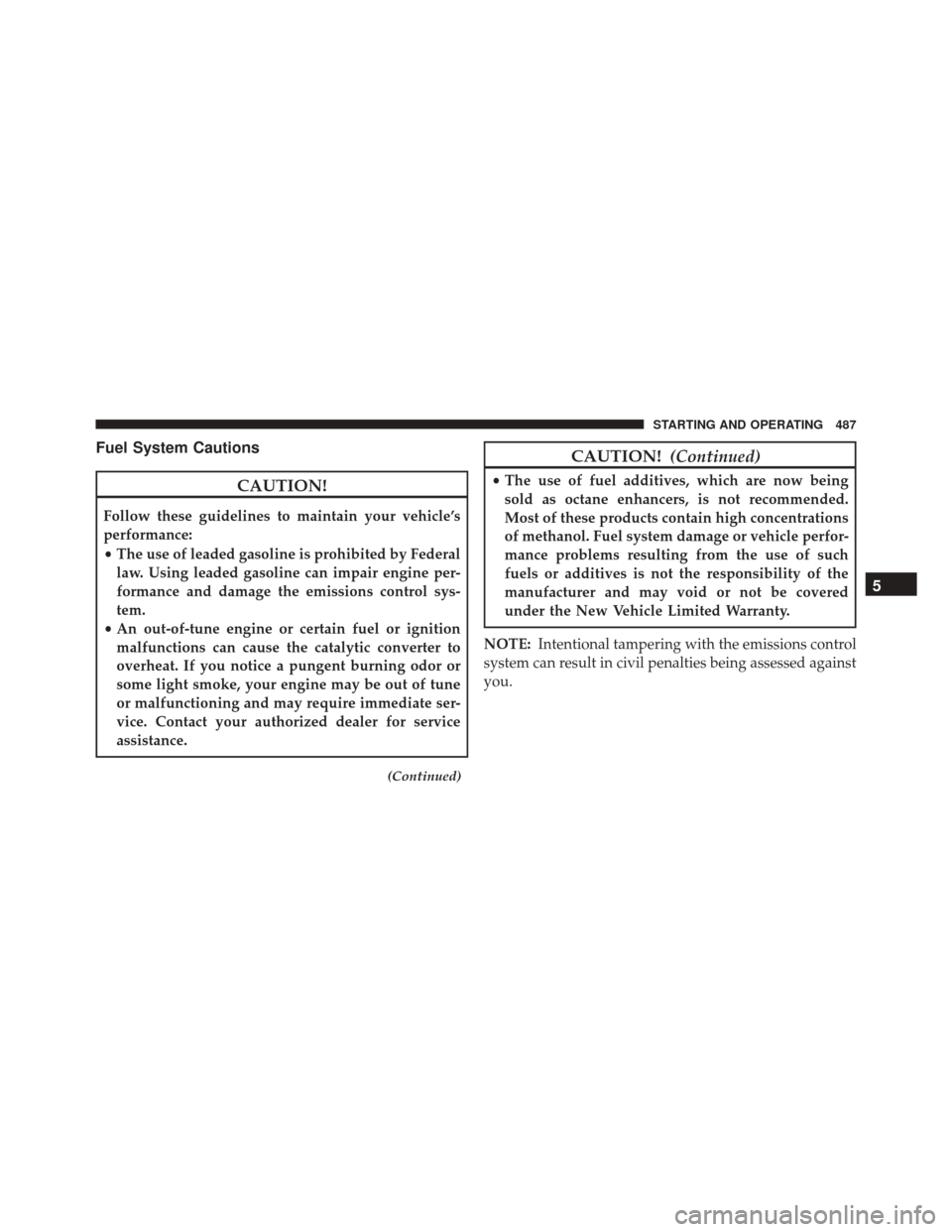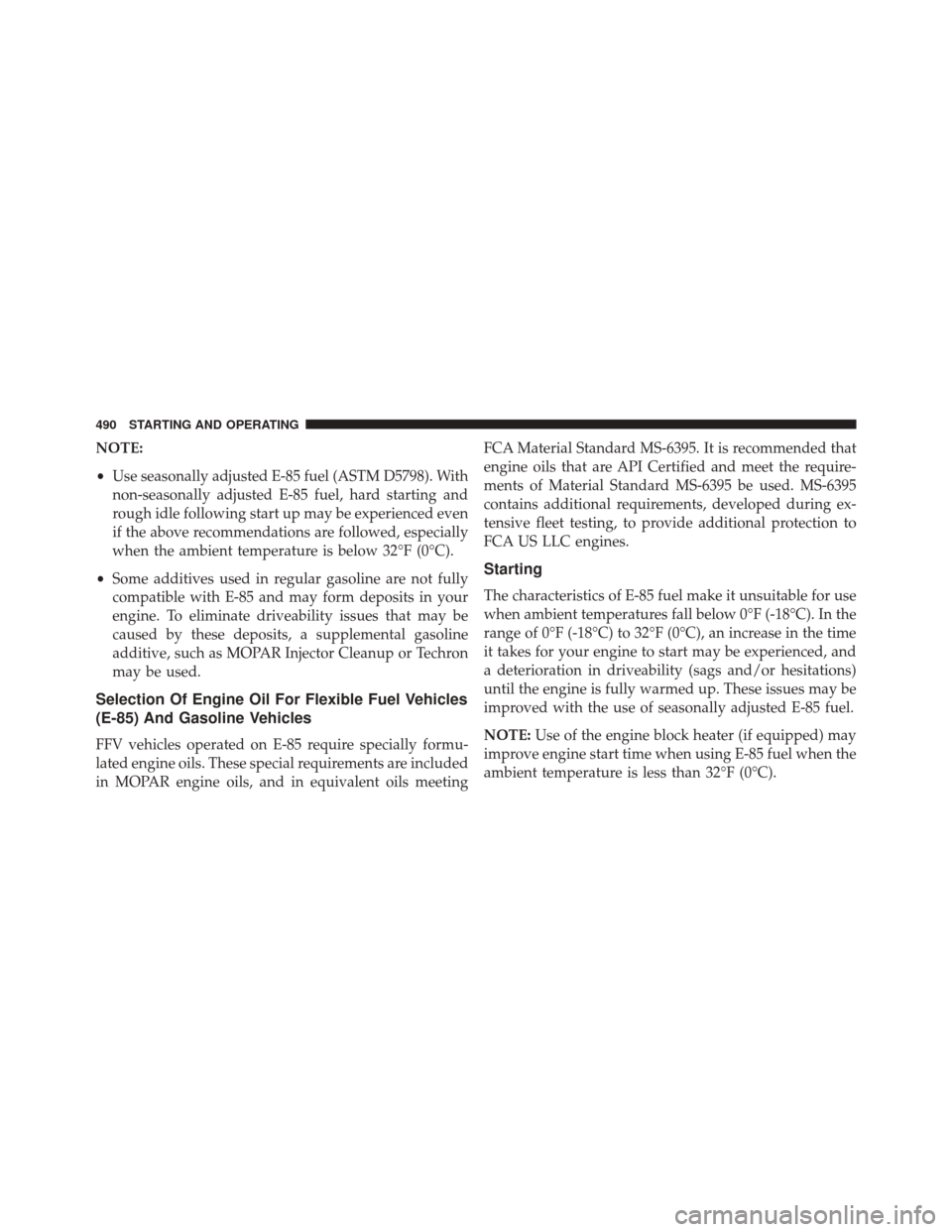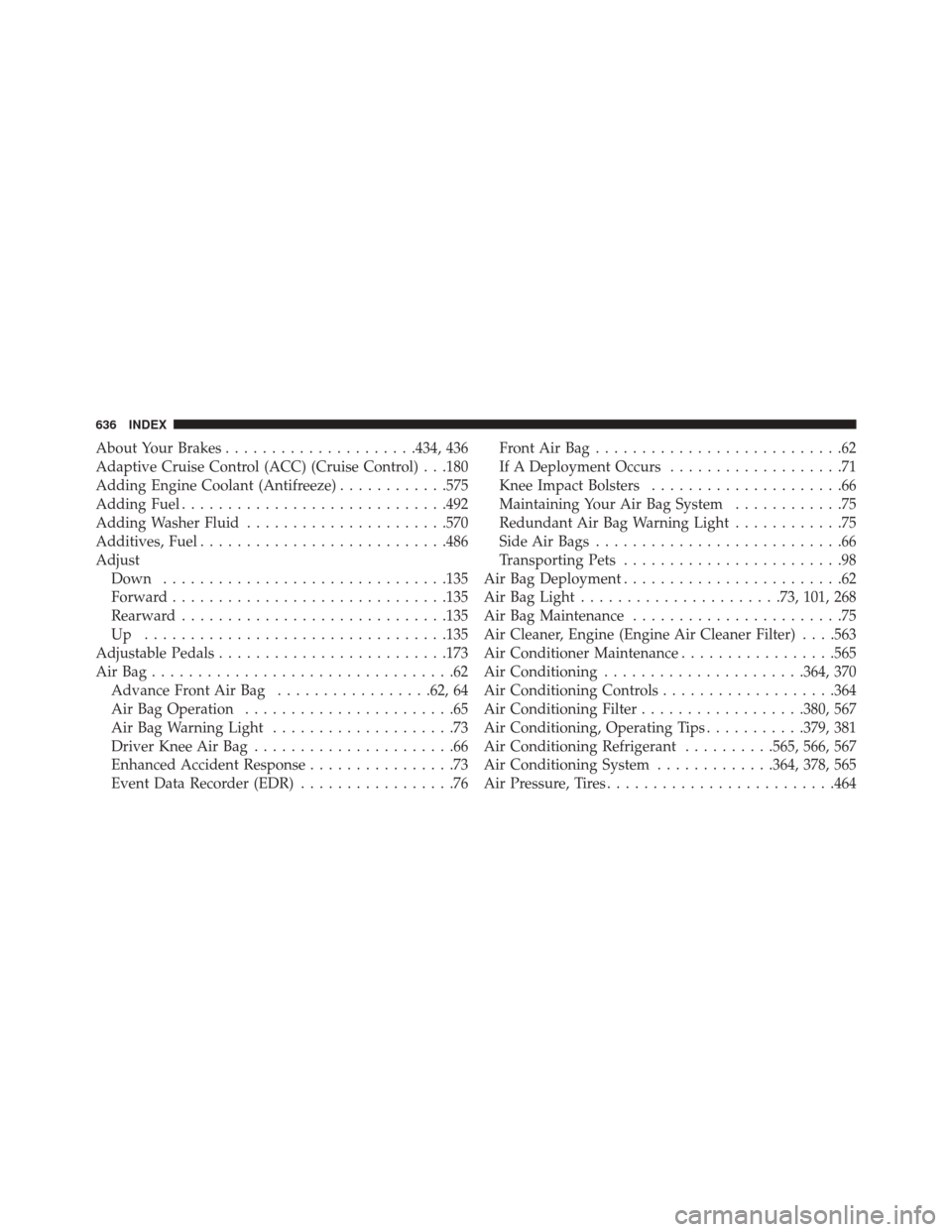2016 DODGE CHARGER fuel additives
[x] Cancel search: fuel additivesPage 488 of 661

MMT In Gasoline
Methylcyclopentadienyl Manganese Tricarbonyl (MMT)
is a manganese-containing metallic additive that is
blended into some gasoline to increase octane. Gasoline
blended with MMT provides no performance advantage
beyond gasoline of the same octane number without
MMT. Gasoline blended with MMT reduces spark plug
life and reduces emissions system performance in some
vehicles. The manufacturer recommends that gasoline
without MMT be used in your vehicle. The MMT content
of gasoline may not be indicated on the gasoline pump,
therefore, you should ask your gasoline retailer whether
the gasoline contains MMT. MMT is prohibited in Federal
and California reformulated gasoline.
Materials Added To Fuel
Besides using unleaded gasoline with the proper octane
rating, gasolines that contain detergents, corrosion and
stability additives are recommended. Using gasolines
that have these additives will help improve fuel
economy, reduce emissions, and maintain vehicle perfor-
mance. Designated TOP TIER Detergent Gasoline con-
tains a higher level of detergents to further aide in
minimizing engine and fuel system deposits. When avail-
able the usage of Top Tier Detergent gasoline is recom-
mended. Visit www.toptiergas.com for a list of TOP TIER
Detergent Gasoline Retailers.
Indiscriminate use of fuel system cleaning agents should
be avoided. Many of these materials intended for gum
and varnish removal may contain active solvents or
similar ingredients. These can harm fuel system gasket
and diaphragm materials.
486 STARTING AND OPERATING
Page 489 of 661

Fuel System Cautions
CAUTION!
Follow these guidelines to maintain your vehicle’s
performance:
•The use of leaded gasoline is prohibited by Federal
law. Using leaded gasoline can impair engine per-
formance and damage the emissions control sys-
tem.
• An out-of-tune engine or certain fuel or ignition
malfunctions can cause the catalytic converter to
overheat. If you notice a pungent burning odor or
some light smoke, your engine may be out of tune
or malfunctioning and may require immediate ser-
vice. Contact your authorized dealer for service
assistance.
(Continued)
CAUTION! (Continued)
•The use of fuel additives, which are now being
sold as octane enhancers, is not recommended.
Most of these products contain high concentrations
of methanol. Fuel system damage or vehicle perfor-
mance problems resulting from the use of such
fuels or additives is not the responsibility of the
manufacturer and may void or not be covered
under the New Vehicle Limited Warranty.
NOTE: Intentional tampering with the emissions control
system can result in civil penalties being assessed against
you.
5
STARTING AND OPERATING 487
Page 492 of 661

NOTE:
•Use seasonally adjusted E-85 fuel (ASTM D5798). With
non-seasonally adjusted E-85 fuel, hard starting and
rough idle following start up may be experienced even
if the above recommendations are followed, especially
when the ambient temperature is below 32°F (0°C).
• Some additives used in regular gasoline are not fully
compatible with E-85 and may form deposits in your
engine. To eliminate driveability issues that may be
caused by these deposits, a supplemental gasoline
additive, such as MOPAR Injector Cleanup or Techron
may be used.
Selection Of Engine Oil For Flexible Fuel Vehicles
(E-85) And Gasoline Vehicles
FFV vehicles operated on E-85 require specially formu-
lated engine oils. These special requirements are included
in MOPAR engine oils, and in equivalent oils meeting FCA Material Standard MS-6395. It is recommended that
engine oils that are API Certified and meet the require-
ments of Material Standard MS-6395 be used. MS-6395
contains additional requirements, developed during ex-
tensive fleet testing, to provide additional protection to
FCA US LLC engines.
Starting
The characteristics of E-85 fuel make it unsuitable for use
when ambient temperatures fall below 0°F (-18°C). In the
range of 0°F (-18°C) to 32°F (0°C), an increase in the time
it takes for your engine to start may be experienced, and
a deterioration in driveability (sags and/or hesitations)
until the engine is fully warmed up. These issues may be
improved with the use of seasonally adjusted E-85 fuel.
NOTE:
Use of the engine block heater (if equipped) may
improve engine start time when using E-85 fuel when the
ambient temperature is less than 32°F (0°C).
490 STARTING AND OPERATING
Page 638 of 661

About Your Brakes.....................434, 436
Adaptive Cruise Control (ACC) (Cruise Control) . . .180
Adding Engine Coolant (Antifreeze) ............575
Adding Fuel ............................ .492
Adding Washer Fluid ..................... .570
Additives, Fuel .......................... .486
Adjust Down .............................. .135
Forward ............................. .135
Rearward ............................ .135
Up ................................ .135
Adjustable Pedals ........................ .173
AirBag.................................62 Advance Front Air Bag .................62, 64
Air Bag Operation .......................65
Air Bag Warning Light ....................73
Driver Knee Air Bag ......................66
Enhanced Accident Response ................73
Event Data Recorder (EDR) .................76 FrontAirBag...........................62
If A Deployment Occurs
...................71
Knee Impact Bolsters .....................66
Maintaining Your Air Bag System ............75
Redundant Air Bag Warning Light ............75
Side Air Bags ...........................66
Transporting Pets ........................98
Air Bag Deployment ........................62
Air Bag Light ..................... .73, 101, 268
Air Bag Maintenance .......................75
Air Cleaner, Engine (Engine Air Cleaner Filter) . . . .563
Air Conditioner Maintenance .................565
Air Conditioning ..................... .364, 370
Air Conditioning Controls ...................364
Air Conditioning Filter ..................380, 567
Air Conditioning, Operating Tips ...........379, 381
Air Conditioning Refrigerant ..........565, 566, 567
Air Conditioning System .............364, 378, 565
Air Pressure, Tires ........................ .464
636 INDEX
Page 645 of 661

Floor Console........................... .251
Fluid, Brake ......................... .613, 616
Fluid Capacities ..........................611
Fluid Leaks ............................ .104
Fluid Level Checks ....................... .583
Automatic Transmission ..................582
Brake ............................... .579
Cooling System ........................ .573
Engine Oil ........................... .559
Transfer Case ......................... .583
Fluids, Lubricants And Genuine Parts ...........613
Fog Lights ............................. .158
Folding Rear Seat ........................ .146
Forward Collision Warning ..................207
Freeing A Stuck Vehicle .....................539
Fuel .................................. .483
Additives ............................ .486
Clean Air ............................ .484
Ethanol .......................... .485, 488Gasoline
............................. .483
Light ............................... .285
Materials Added ....................... .486
Methanol ............................ .485
Octane Rating ................483, 613, 614, 615
Requirements ......................... .483
Specifications ...................613, 614, 615
Tank Capacity ..........................611
Fuel, Flexible ........................... .488
Fuses ................................. .590
Garage Door Opener (HomeLink) ..........232, 239
Gasoline, Clean Air ....................... .484
Gasoline (Fuel) .......................... .483
Gasoline, Reformulated .....................484
Gear Ranges ............................ .419
Glass Cleaning .......................... .589
Gr
oss Axle Weight Rating ................496, 498
Gross Vehicle Weight Rating ..............496, 49710
INDEX 643